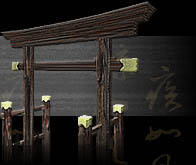



Division Based Control: The player controls whole groups of up to 40 units at one time, instead of individual soldiers. This is the only reasonable way to control such large armies. It is also realistic – the player is at the executive level of the army. Units cannot be reassigned new divisions. Samurai Generals employed their own troops, and soldiers were not re-hired in battle.
Focus on Tactics and Strategy: The player will be able to take an army to its fullest potential in combat. By learning to use different division types, positioning and fallback strategies, flanking maneuvers, use of detachments, and so on, the player will feel like he or she is in command of a living army.
Battles of Epic Scale: Each army can possess up to 12 divisions of up to 40 units each; for a maximum total of 480 units per army, or 960 units on the battlefield at a single time.
Historically Accurate Formations: The player can choose among 16 army formations, and 12 division formations, all based on real historical formations used in Samurai warfare.
Morale and Fatigue System: Units respond realistically. They get tired in combat or when running, they get fearful when they are injured or their commanders die. A crafty player can defeat superior numbers using psychological warfare on the battlefield.
Role-Playing Aspects: Characters in campaign and dual modes will improve automatically with experience. This will encourage the player to take care of his or her experienced officers and divisions, while at the same time using them wisely to develop their skills. Also, commanders in Takeda have their own personalities, and will behave differently in combat.
Tournament Style Multiplayer Mode: In head-to-head mode, the performance of each player is tracked so that it can be viewed online when engaging an opponent. The number of victories and defeats a player has accumulated, his or her army statistics, and an overall rank can be viewed before engaging in an online battle.
Weather / Environmental Effects: Drifting fog, morning mist, and changes in daylight levels all add atmosphere to the game. Certain game effects will also occur as a result. For example, the distance that units can see will depend on the weather and lighting.
Historically Based Storyline: Takeda is based on real history, with a non-linear storyline that allows the player to explore the possible paths that could have been taken by Takeda Shingen and his clan. The player can reach the same turning points that Takeda did, but does not have to go the same way. Over 40 battles are available in campaign mode, although which ones are actually played will depend on the path taken through the plot.
Detailed Units and Animation: Every unit in Takeda has been painstakingly rendered with a 3D modeling package. Motion capture data was used to generate the unit animations. Dust trails, splashes, and other effects are also added depending on the actions of the unit.
Detailed Maps: Large rendered maps form the backdrop for combat. Various map features influence game play: units tire faster and move slower when running up hills, trees can slow cavalry charges, and so on.
No Resource Development: The player is free to concentrate on battle and strategy, and does not have to micromanage peasants or worry about gathering resources. Units are replaced automatically between battles, based on the economic status of the clan.
Simple Interface: Takeda has a very straightforward and intuitive interface. The basics can be mastered in a very short time. Unit types are balanced to provide variety without making the game unnecessarily complicated.